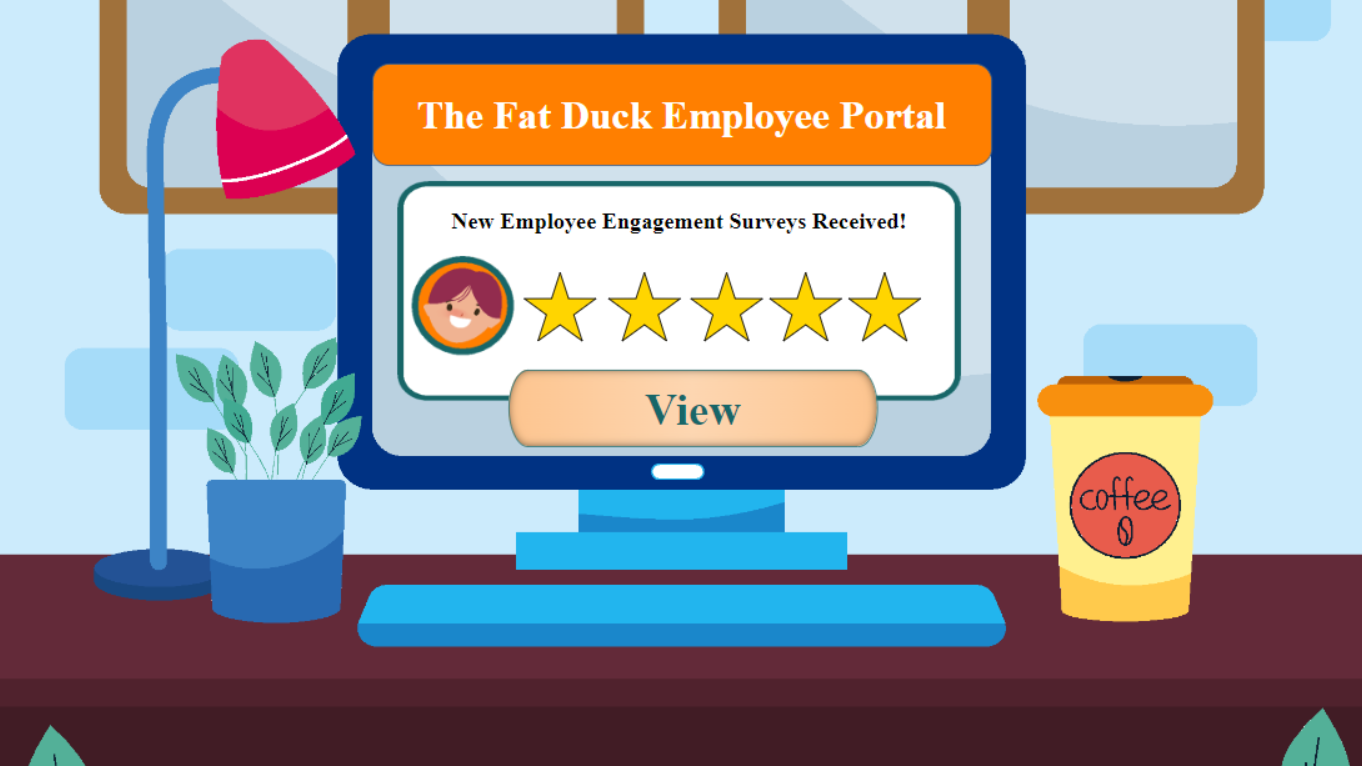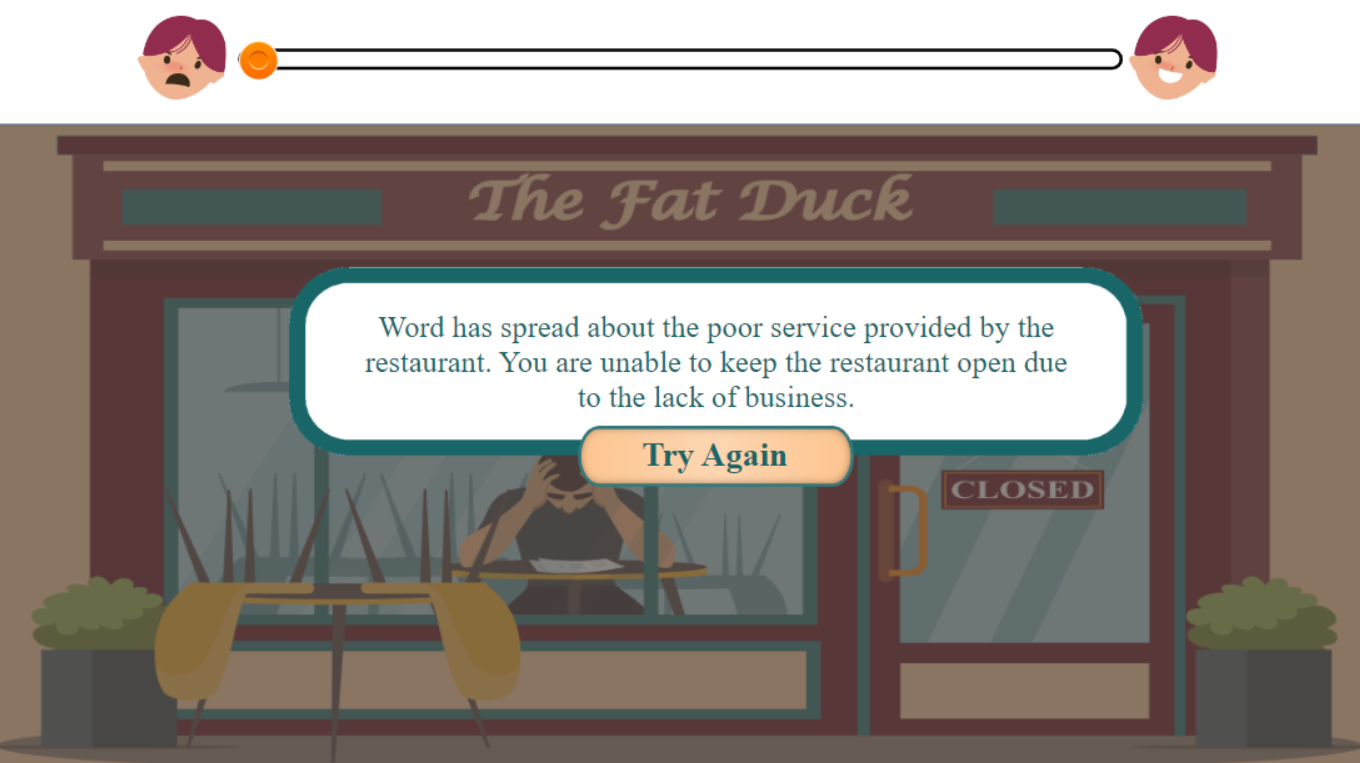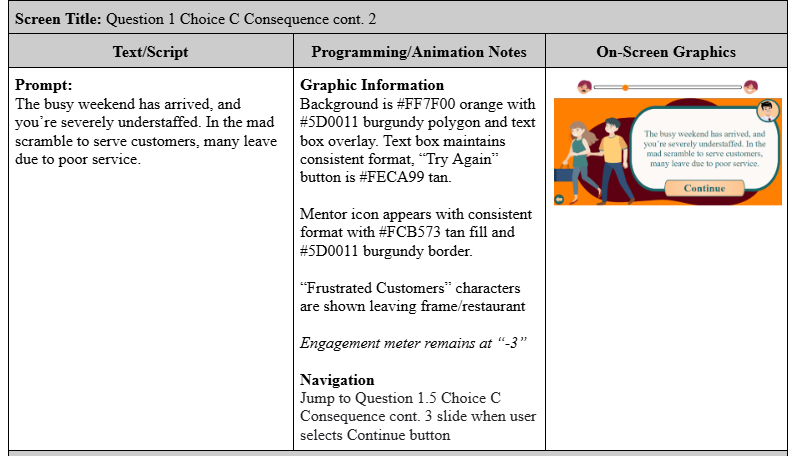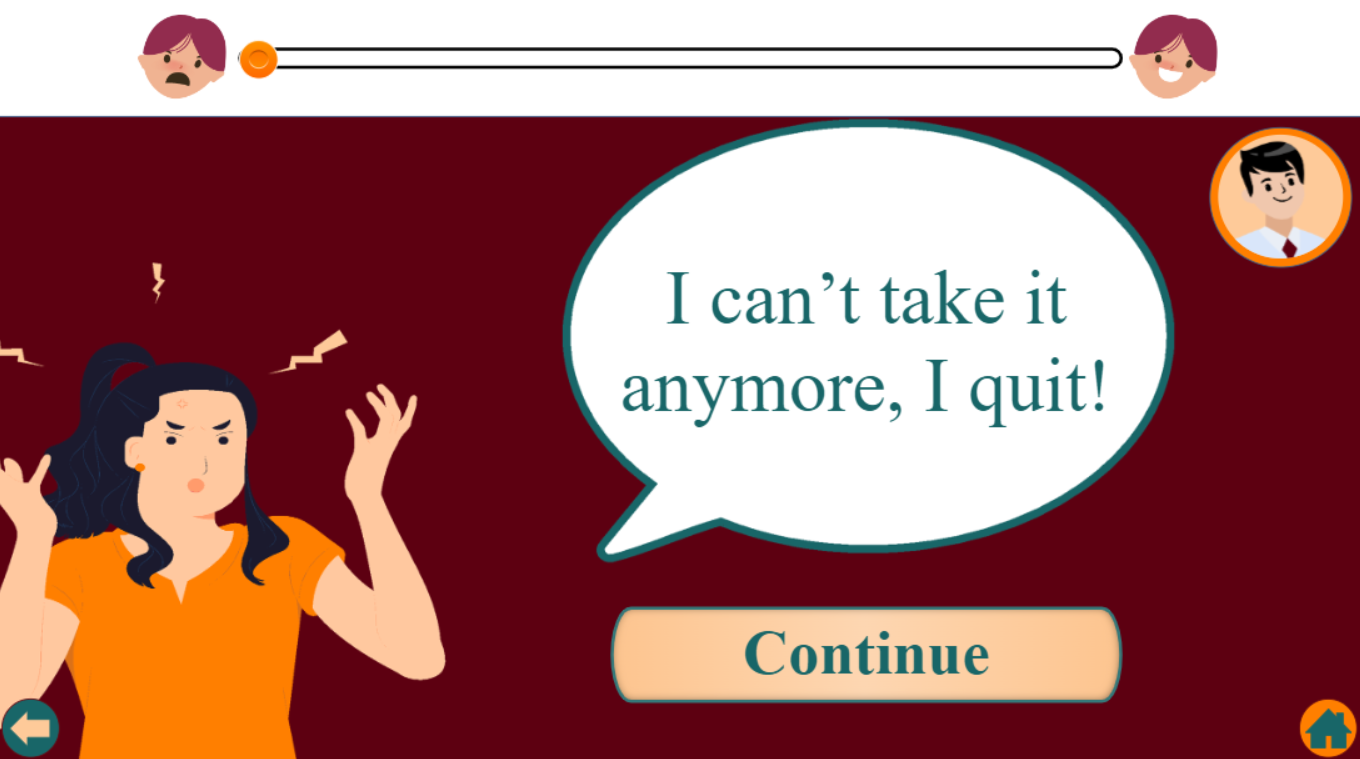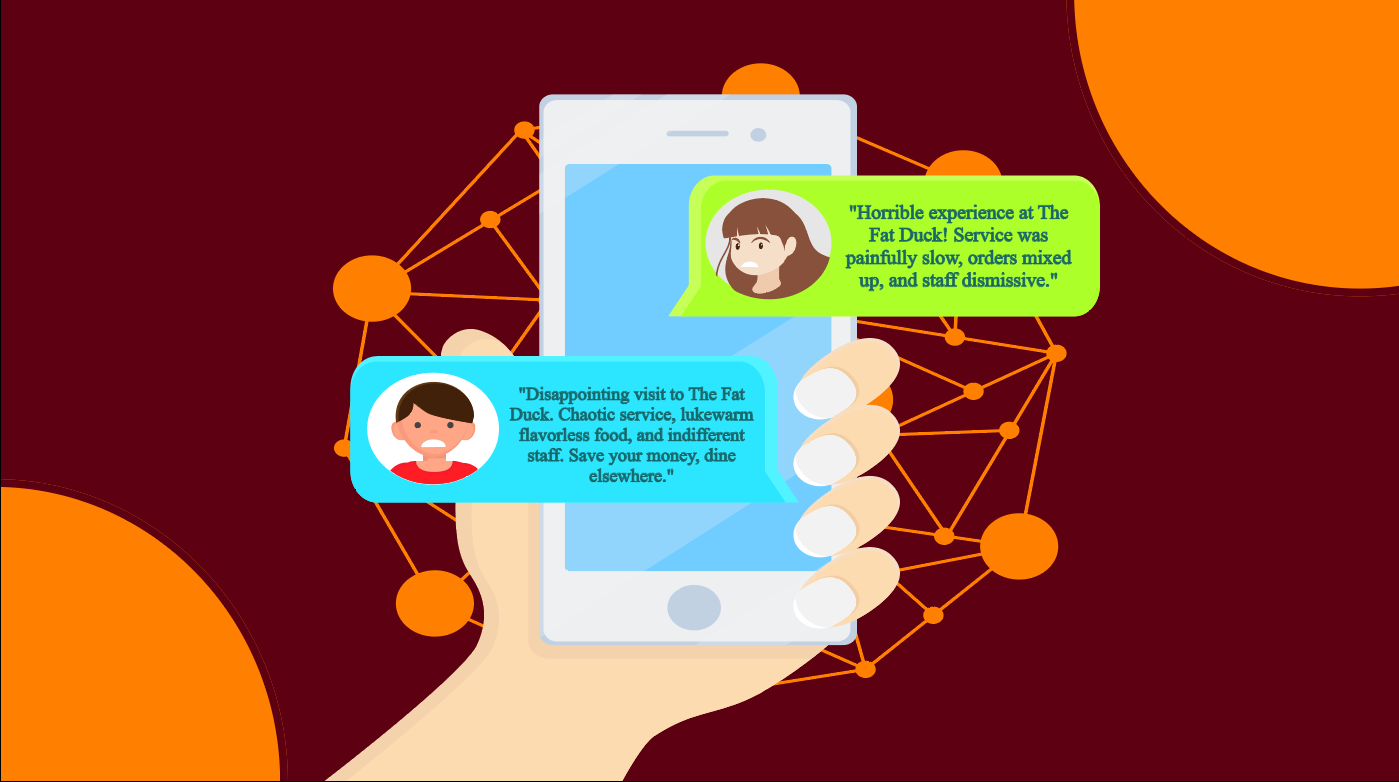Cooking Up Employee Incentive
I designed this scenario-based eLearning concept project for newly-hired or struggling restaurant managers to practice leadership skills when dealing with common challenges in the service industry.
Overview
Audience: Newly-hired restaurant managers or those in need of leadership training
Responsibilities: Instructional Design, eLearning Development, Visual Design, Storyboarding, Action Mapping, Prototyping
Tools Used: Articulate Storyline 360, Adobe XD, MindMeister, Adobe Creative Suite
The Fat Duck (a fictitious client for this concept project) was experiencing a lack of leadership from their restaurant management team. This led to costly consequences, including poor customer experiences, unhappy employees, and high turnover.
After analyzing the performance problem, I confirmed that management lacked the skill and knowledge required to address these situations successfully. I proposed a scenario-based eLearning experience where the managers could practice making decisions that optimize the experience for both their customers and employees.
Our goal was to improve customer engagement, improve employee engagement, and reduce the financial impacts of the problem by providing new hires, and those who are struggling, with a risk-free environment to make choices and see consequences. This helps the learner connect their choices with the real-world consequences. I also proposed incorporating a gamified “engagement meter” that reveals the employee’s emotional status. Finally, I suggested presenting employee engagement reports based on the learners’ choices; this mirrors the reports that managers would see on the job.
The client accepted my proposal and we proceeded with the project.
Process
Action Mapping
Text-Based Storyboard
Once the action map was completed and approved, I began working on a text-based storyboard that incorporates these key actions into a cohesive narrative.
I framed the scenario as a restaurant manager’s week leading up to a busy weekend, and I consulted with the SME to ensure each element was grounded in reality.
Although there are several possible situations that may require leadership, I chose gathering employee feedback, handling last minute time-off requests from employees, and facilitating staff meetings. I chose these scenarios due to their importance and common occurrence. Question prompts appear featuring correct choices and realistic distractors as the learner goes through the scenario. I incorporated a mentor to provide assistance and simulate the guidance of actual restaurant leaders.
Visual Mockups
Visual Storyboard
The visual storyboard allowed me to combine my visual mockups created in Adobe XD with the text-based storyboard to have all elements conveniently organized in one place.
Here, I defined the programming for each slide and prepared to develop the interactive prototype.
Interactive Prototype
Full Development
Features
I consulted an experienced restaurant manager as my subject matter expert (SME) to develop the action map and establish the overall goal for this project. We decided to measure progress by monitoring the employee engagement survey data. We then identified the actions required to help restaurant managers exercise effective leadership and improve employee retention.
Selecting an incorrect choice would require the learner to either try again immediately or lead them through an extended sequence where the busy weekend arrives and a customer satisfaction report appears, providing feedback. This approach reveals realistic outcomes, such as poor experiences for both customers and staff, and, in the worst case, the loss of quality employees.
Once the text-based storyboard was revised and approved, I began creating visual mockups for the scenario in Adobe XD. Adobe XD allowed me to experiment with visual elements and layouts in order to settle on something that felt polished and immersive.
I maintained a consistent visual style for each element, from the background to the characters. I also created a custom color palette based on my title slide’s background illustration and got to work on editing each asset to match the color scheme using Adobe Illustrator, a vector editing software.
Another priority was to maintain a logical narrative, which meant sourcing and editing several different restaurants to have realistic settings for each scenario. Lastly, I designed the prompt boxes, buttons, and font to reinforce the goal of improving employee engagement, which led to the minimalist prompts and subtly rounded corners.
Satisfied with the look and feel of my mockups, I developed a visual storyboard to combine the visual mockups and text-based script. Then, it was time to recreate everything in Articulate Storyline to further refine the elements and implement interactivity.
I used Articulate Storyline 360 to create an interactive prototype using the visual mockups and storyboard to establish the scenario’s programming. The prototype consisted of the title screen, scenario introduction, mentor introduction, and the first question’s correct and incorrect consequences.
I incorporated smooth fading transitions and crisp animations for each prompt and slide element to maintain narrative immersion. I also prototyped custom animations of customer feedback appearing from a cell phone using PowerPoint.
The prototype also included the first implementation of the employee’s engagement meter that was used to visually gauge the employee character’s reactions to the learner’s choices.
With the basic framework for the rest of the project established, I shared the prototype seeking feedback on the look, feel, and overall experience of the scenario. The reception was positive and I made minor adjustments to tighten the transition times and made the wording throughout the project more concise. I moved on to the full development once I was satisfied.
The full development of the scenario in Articulate Storyline 360 was straightforward and efficient now that all elements had been created and a programming framework for each consequence was established.
Custom Visuals: I sourced each visual asset from an image repository and edited them using Adobe Illustrator to maintain immersion and cohesive look. This included resizing, editing layers, recoloring individual elements, and merging assets.
Prescriptive Feedback - Mentor: For each question, the learner can access a mentor named David to provide suggestions for their responses. This mentor helps steer the learner toward the correct behavior while providing explanations for why that choice is effective. I created the custom mentor button using Adobe Illustrator to incorporate the mentor cleanly into each question prompt.
Gamification - Engagement Meter: I incorporated the engagement meter as light gamification to help boost learner engagement and contextualize the emotion of the employees’ dialogue. Seeing the meter increase or decrease alongside choices provides immediate feedback while building toward the employee engagement reports. I made the decision to have the meter decrease with correct choices in order to parallel the intended improved engagement of customers and employees.
Employee Engagement Survey: In addition to the engagement meter, employee engagement surveys are received and presented at the end of the experience. The learner is initially shown a five-star rating scale followed by a detailed response from the employee. There are three different reports a learner can see depending on choices selected. Each detailed review provides clues for the learner to help answer the question correctly if they got it wrong.
Scenario Branching - Customers leaving the restaurant: One of the incorrect choices in question 1 leads the learner to question 1.5 where the situation has escalated significantly and they have one last chance to de-escalate. Correctly answering this question moves the learner along to question 2, while incorrectly answering this question leads to customers leaving the restaurant. I created a scene where there is a closed sign hanging on the restaurant door to simulate the disastrous impact that negative customer experiences can have.
Results and Takeaways
I shared the completed project with my network online and was overwhelmed by the positive reception and praise received. Viewers commented on its polished feel while highlighting its immersivity and engaging dialogue. The restaurant manager I consulted was impressed and thought this experience would be an excellent asset for restaurant managers.
There are several directions I would love to take this concept project and improvements I would make with more time and resources:
Additional Characters: Consistently across feedback the most beloved elements were the characters included. I would introduce additional characters to include a wider variety of perspectives and roles within the restaurant. I believe this experience’s strength is its immersion and the inclusion of a comprehensive staff would only heighten that.
Expanded Narrative Pathways: The question 1.5 consequences were a good look at the benefits of expanding pathways and increasing experience re-playability. Despite the restaurant’s closure being a negative consequence, it did provide a moment of delight and discovery as it is something that can be completely missed. I would like to expand these options throughout the experience to broaden the suite of consequences and allow more nuanced engagement reports.
Expanded Employee Situations: This experience only features a few employee scenarios, but there are far more situations that require effective leadership. A fully expanded experience would present multiple employee and customer situations requiring different actions. This array of employees and customers could be presented randomly or sequentially, and would increase the efficacy of the experience.



